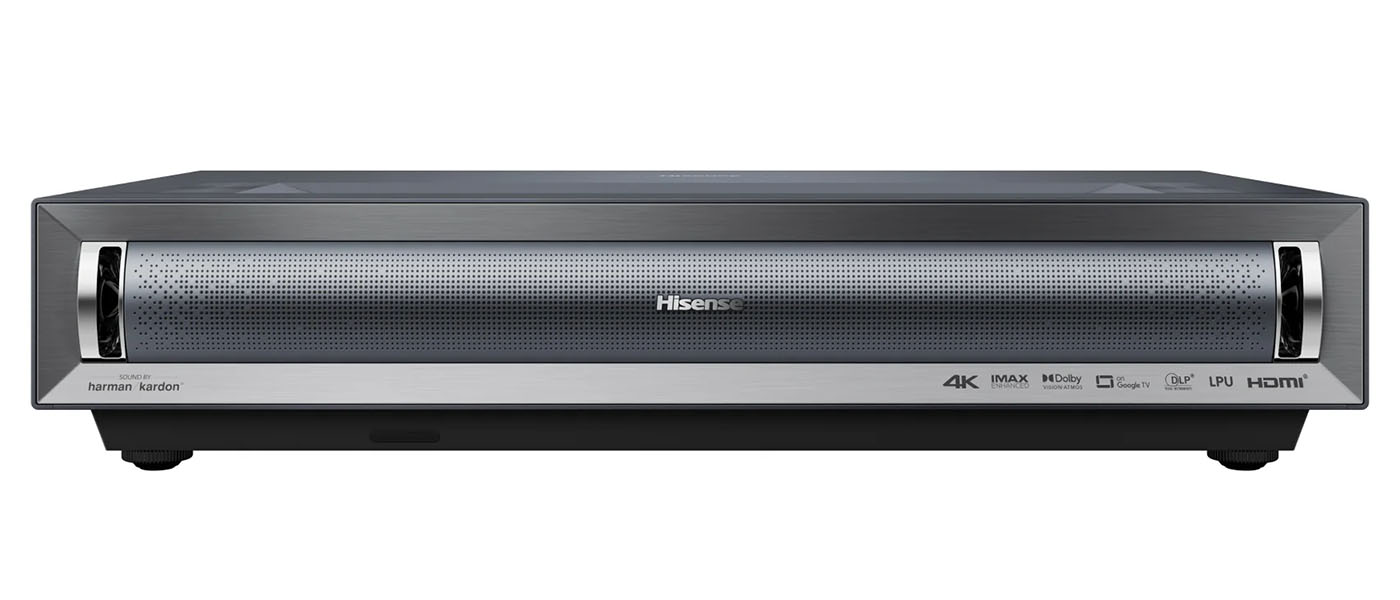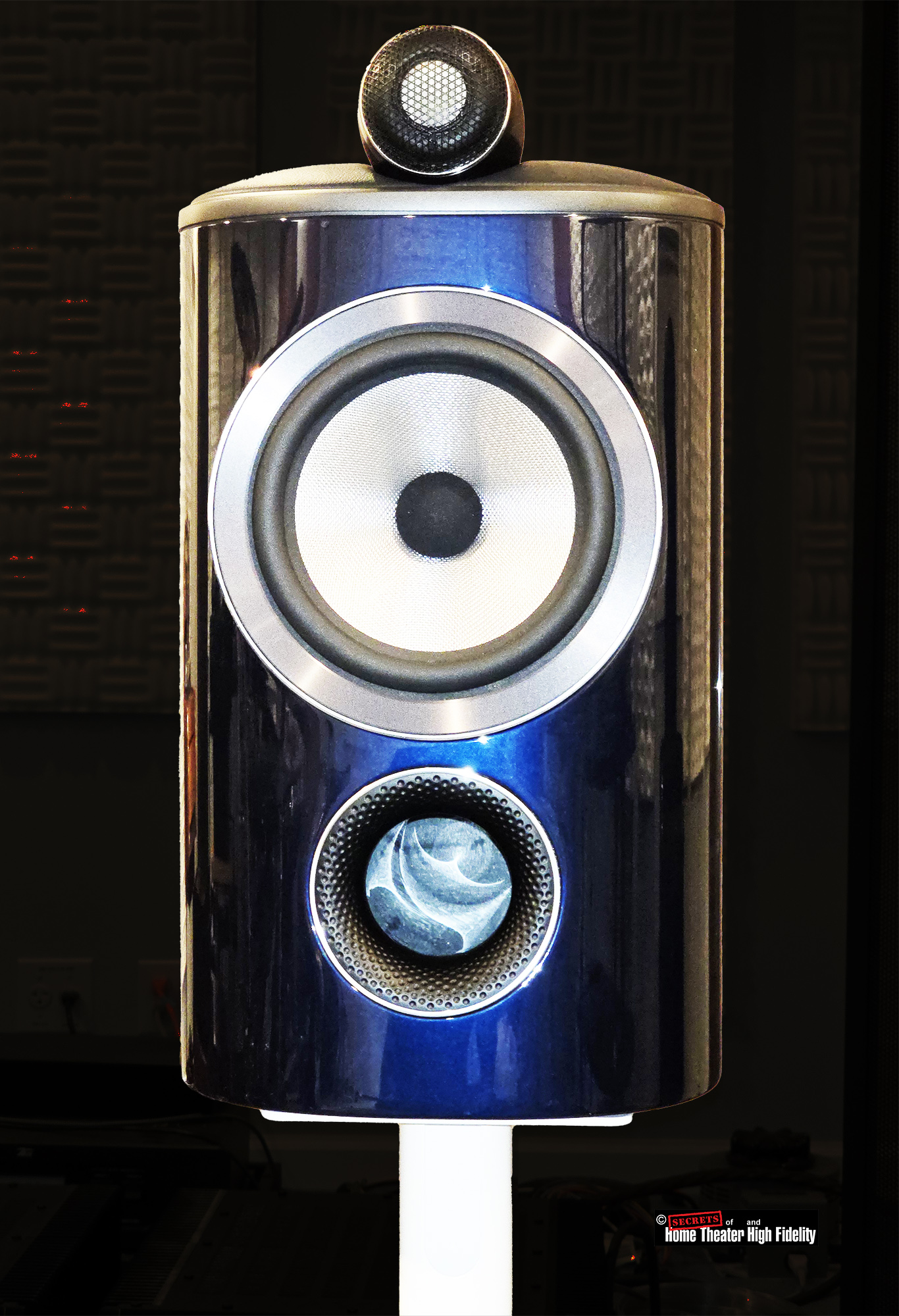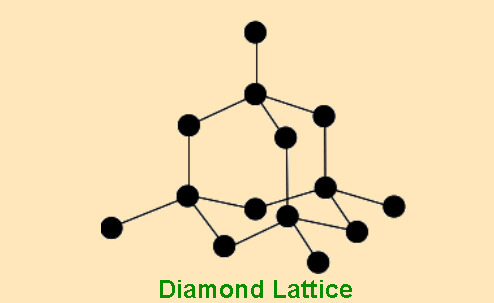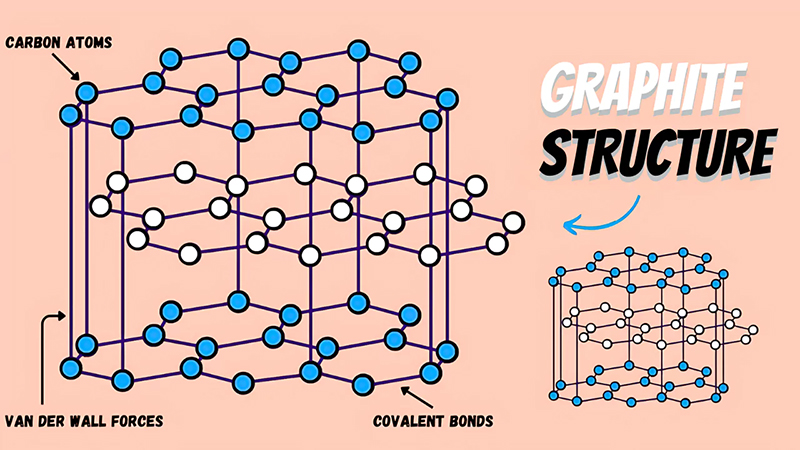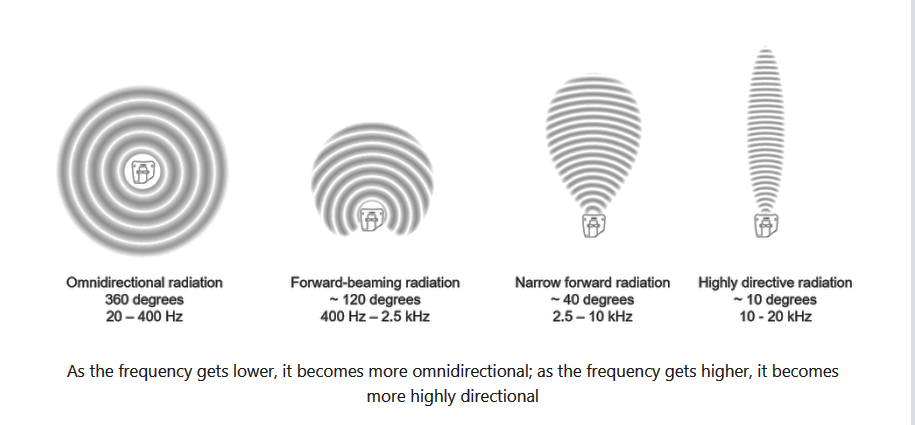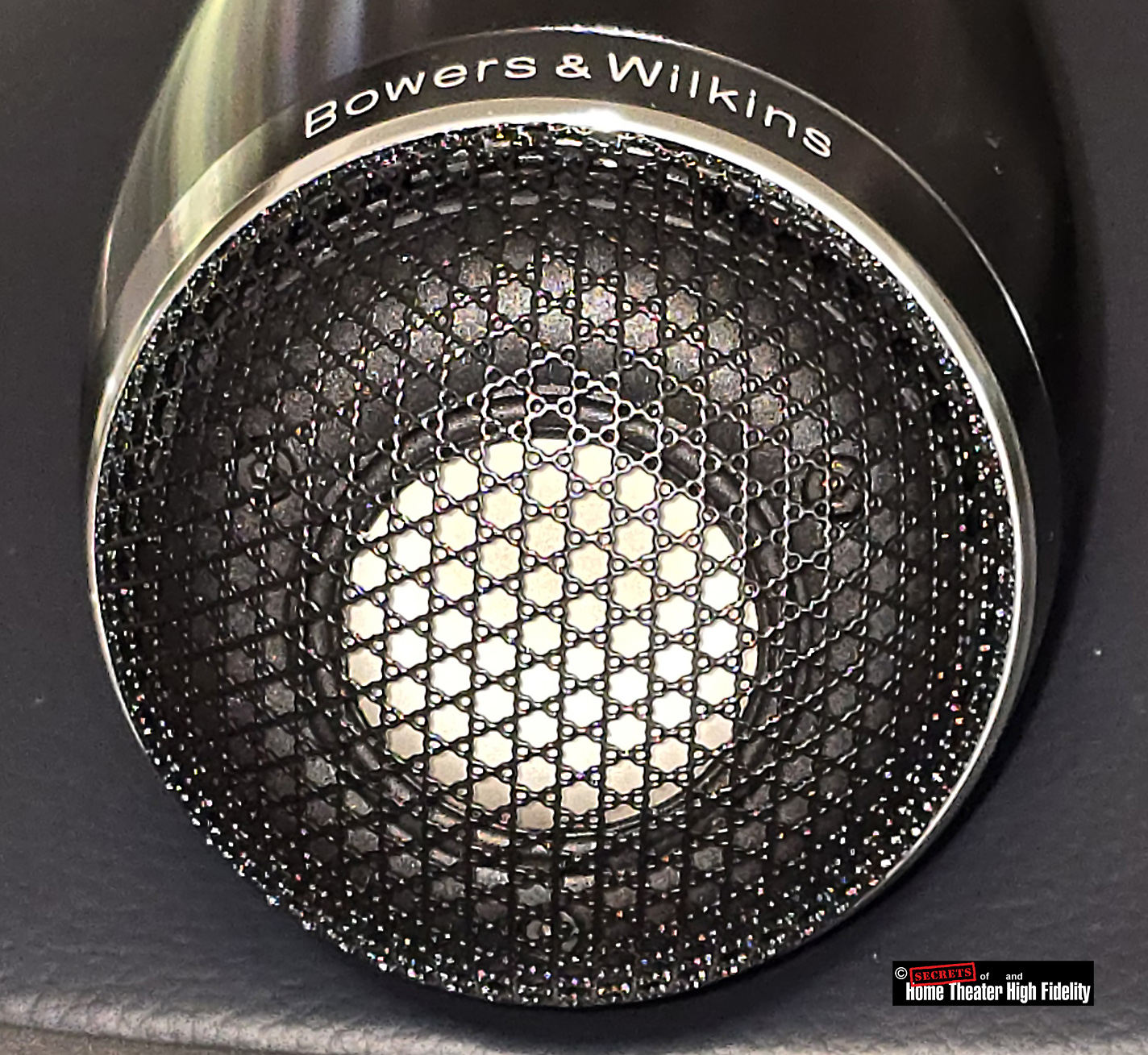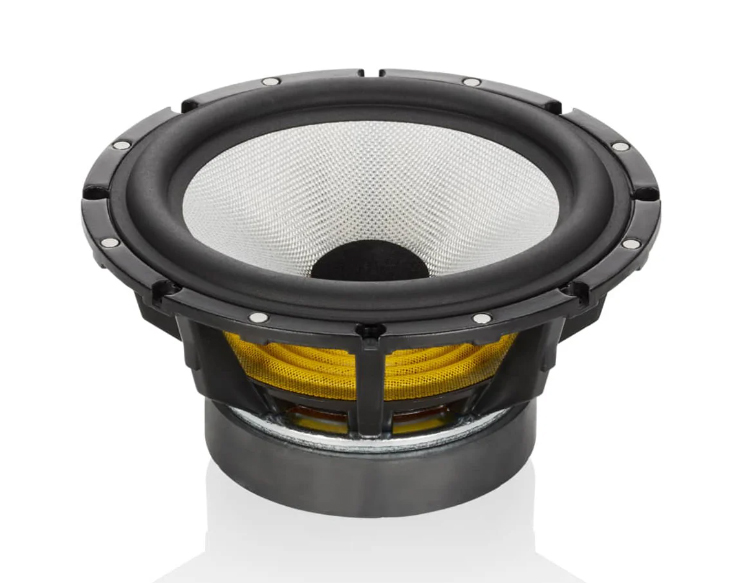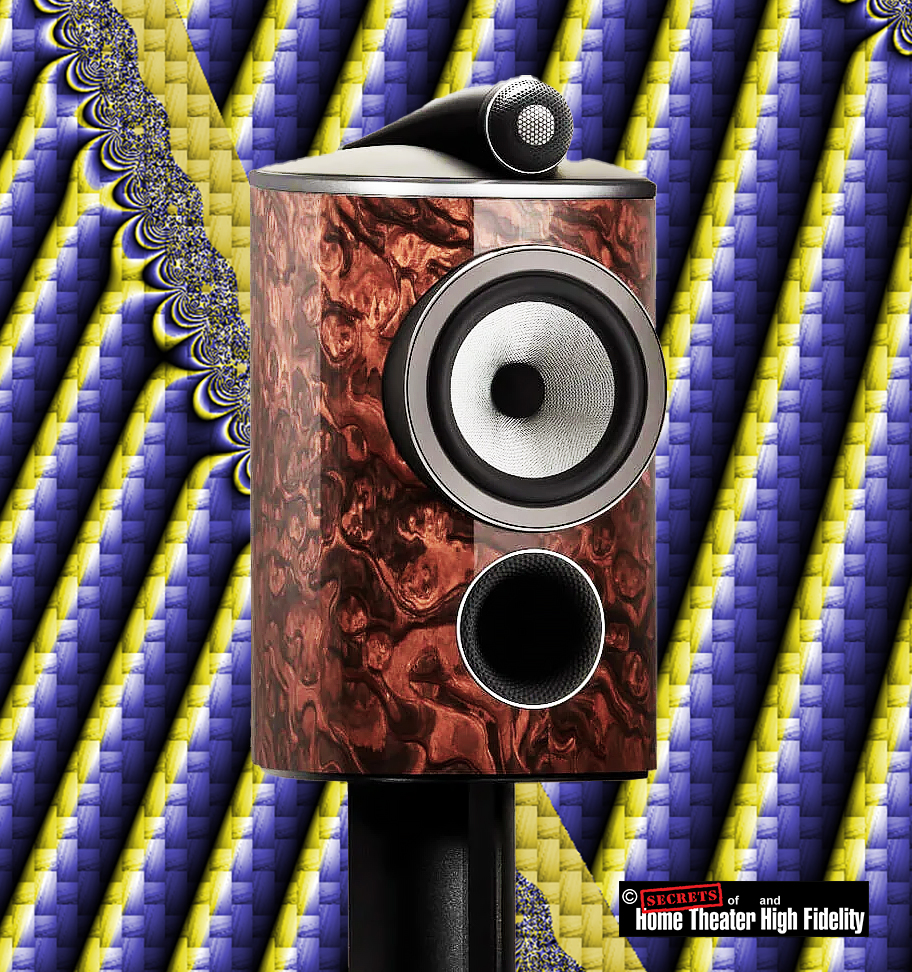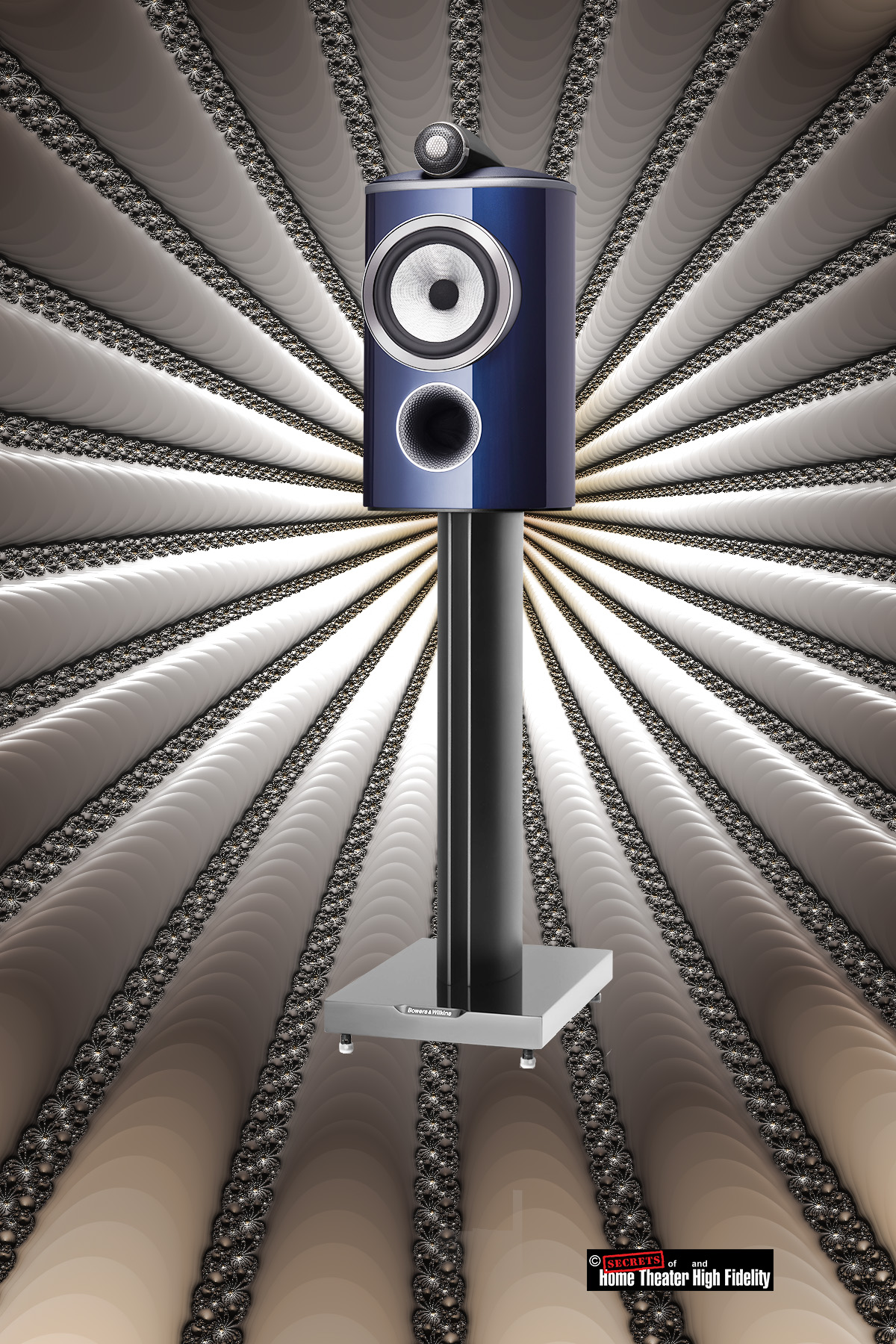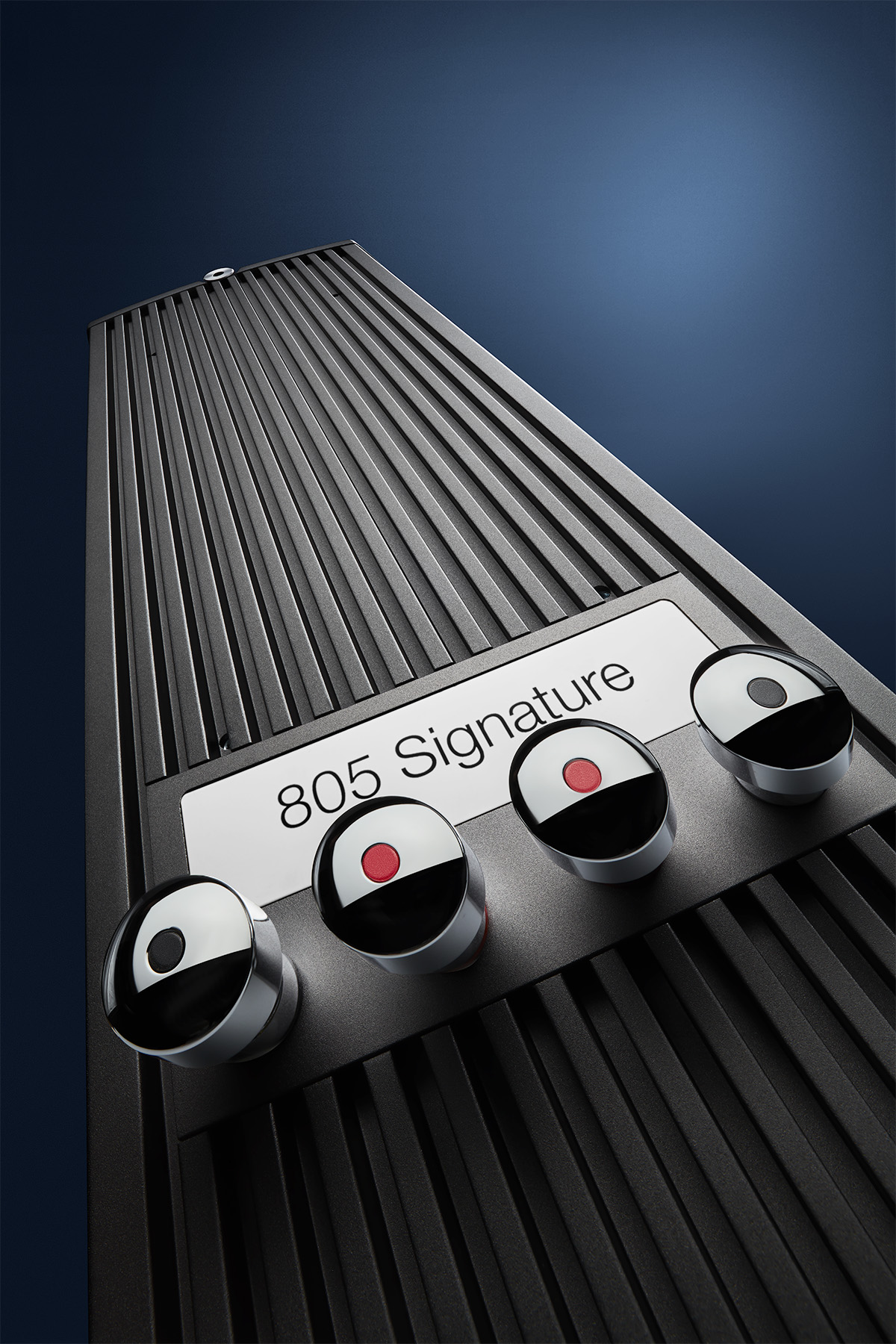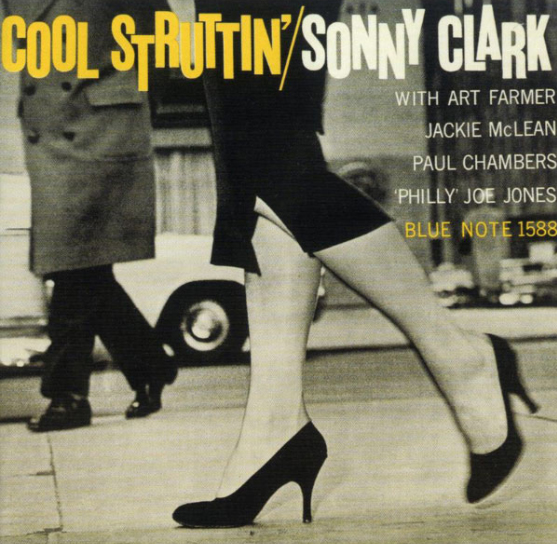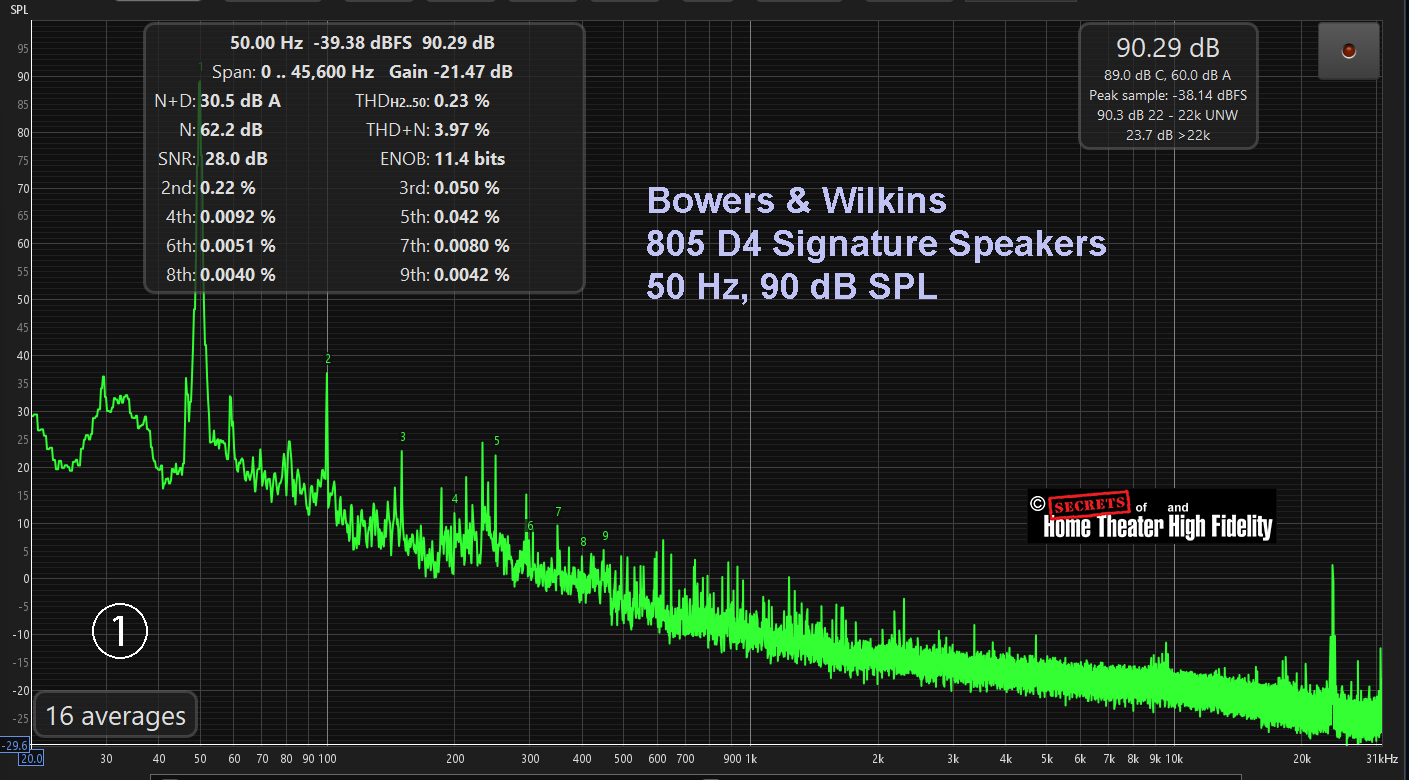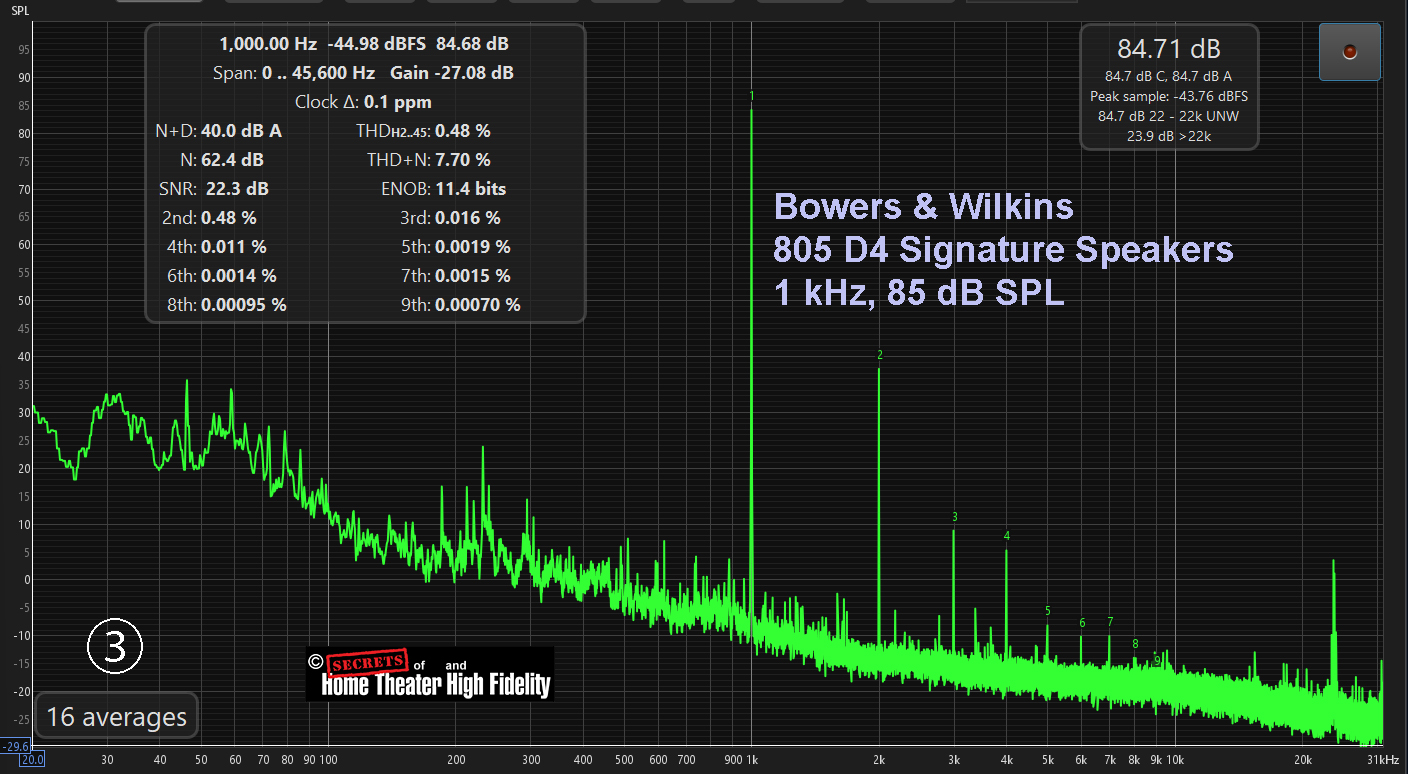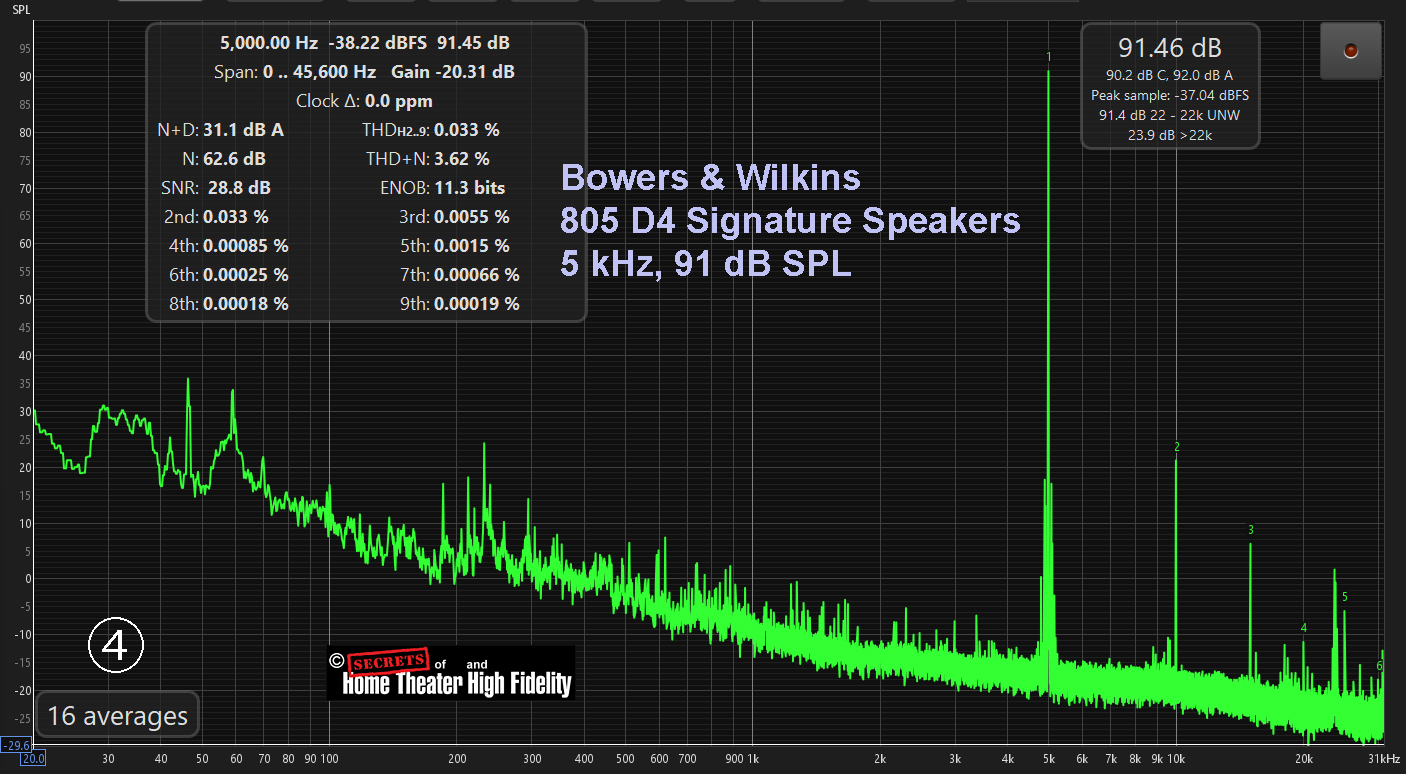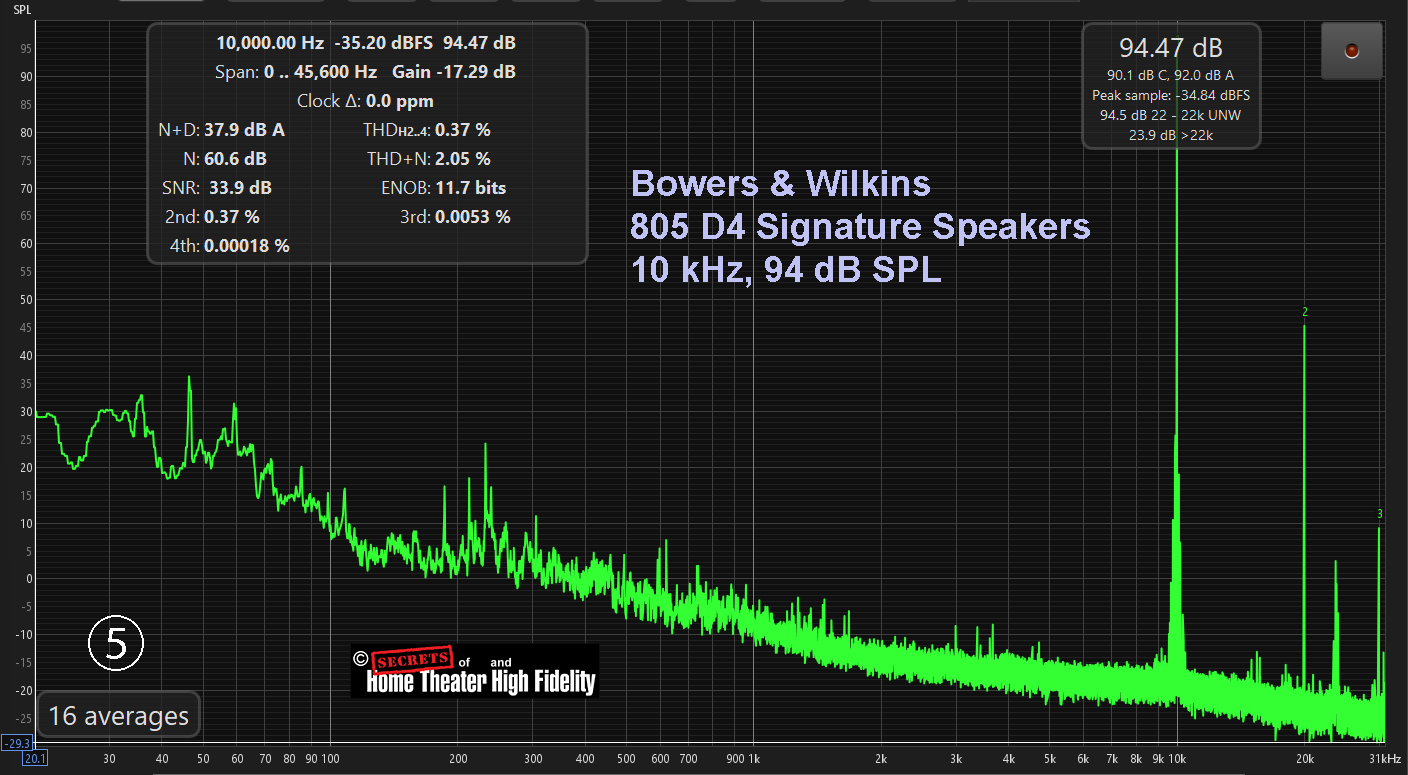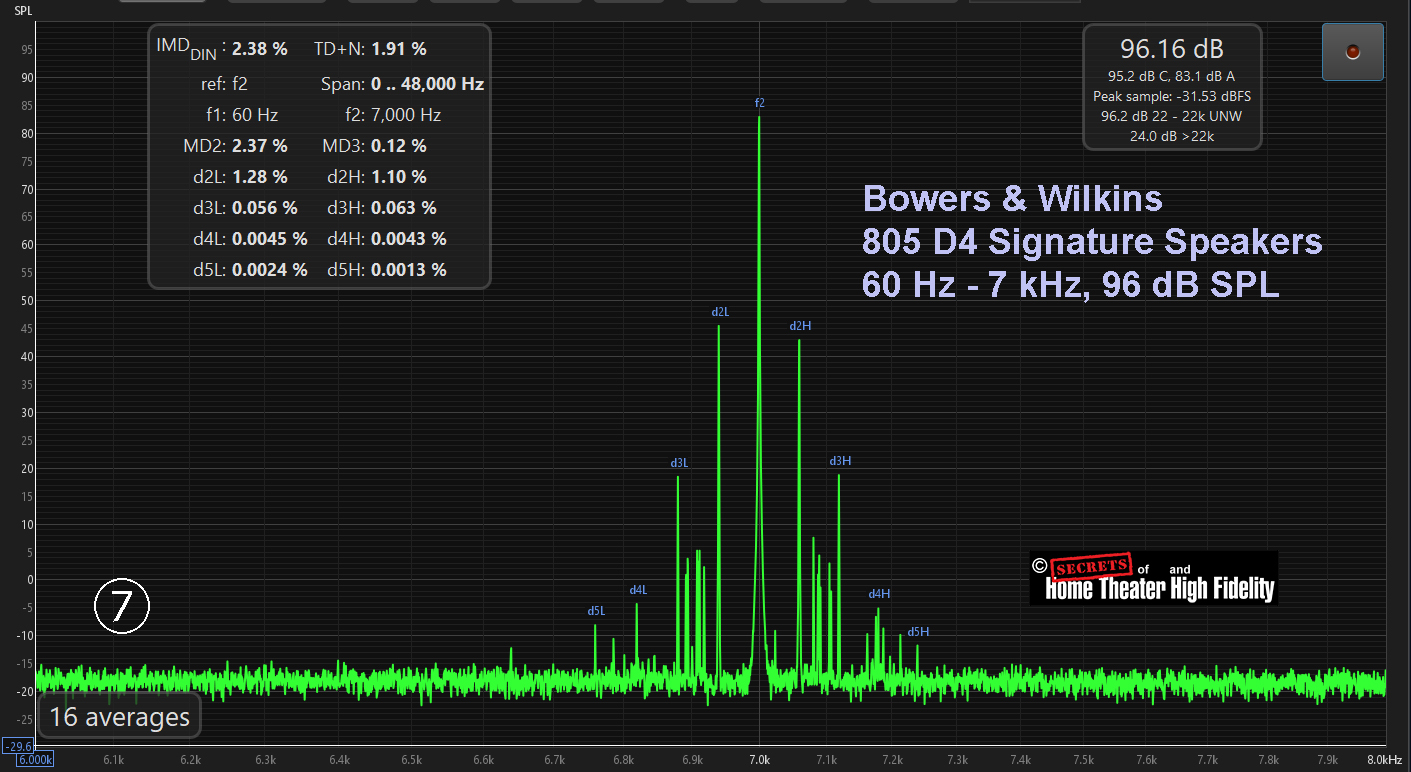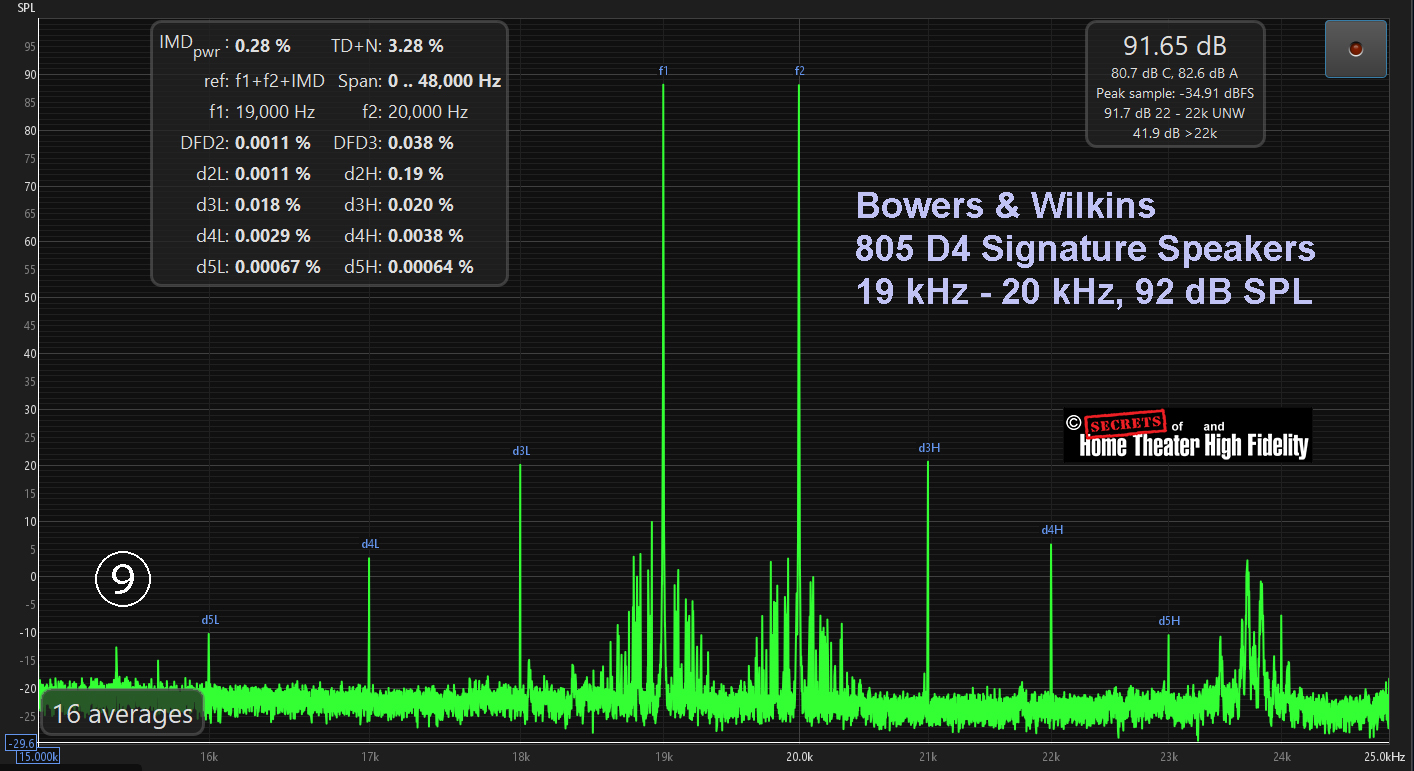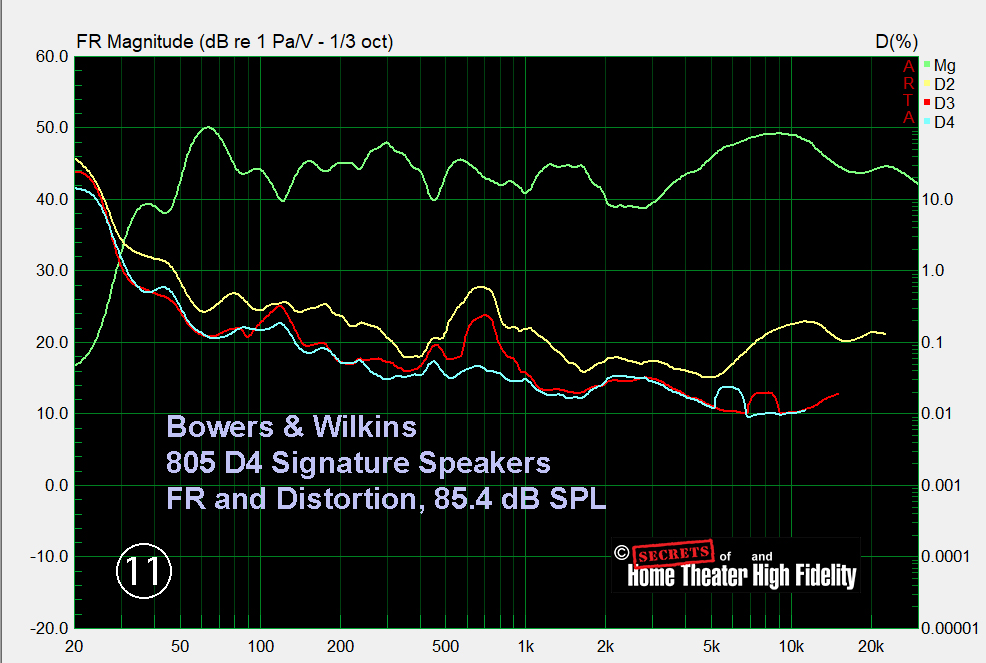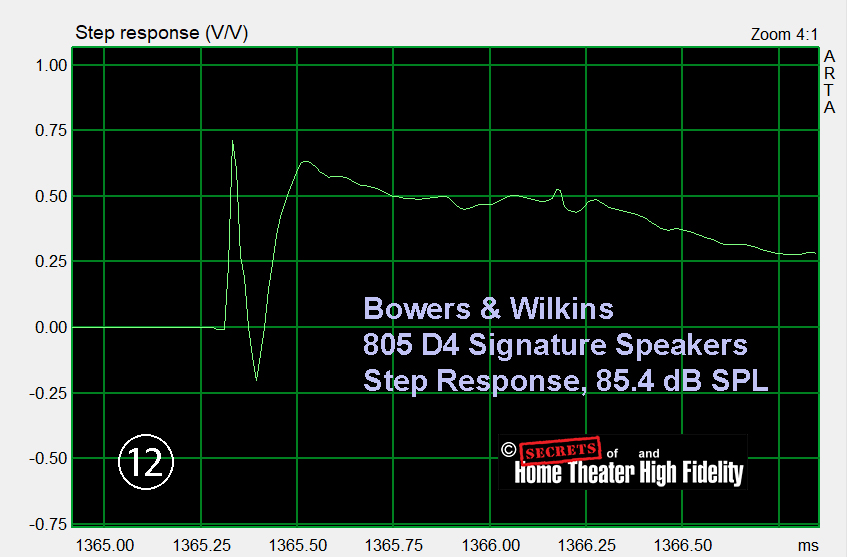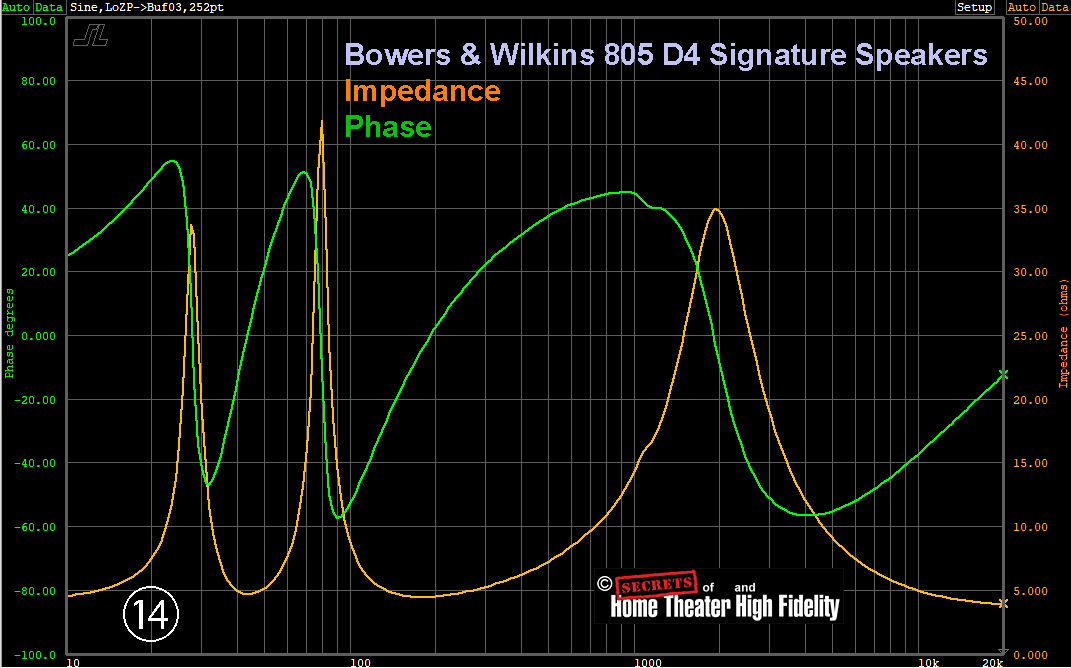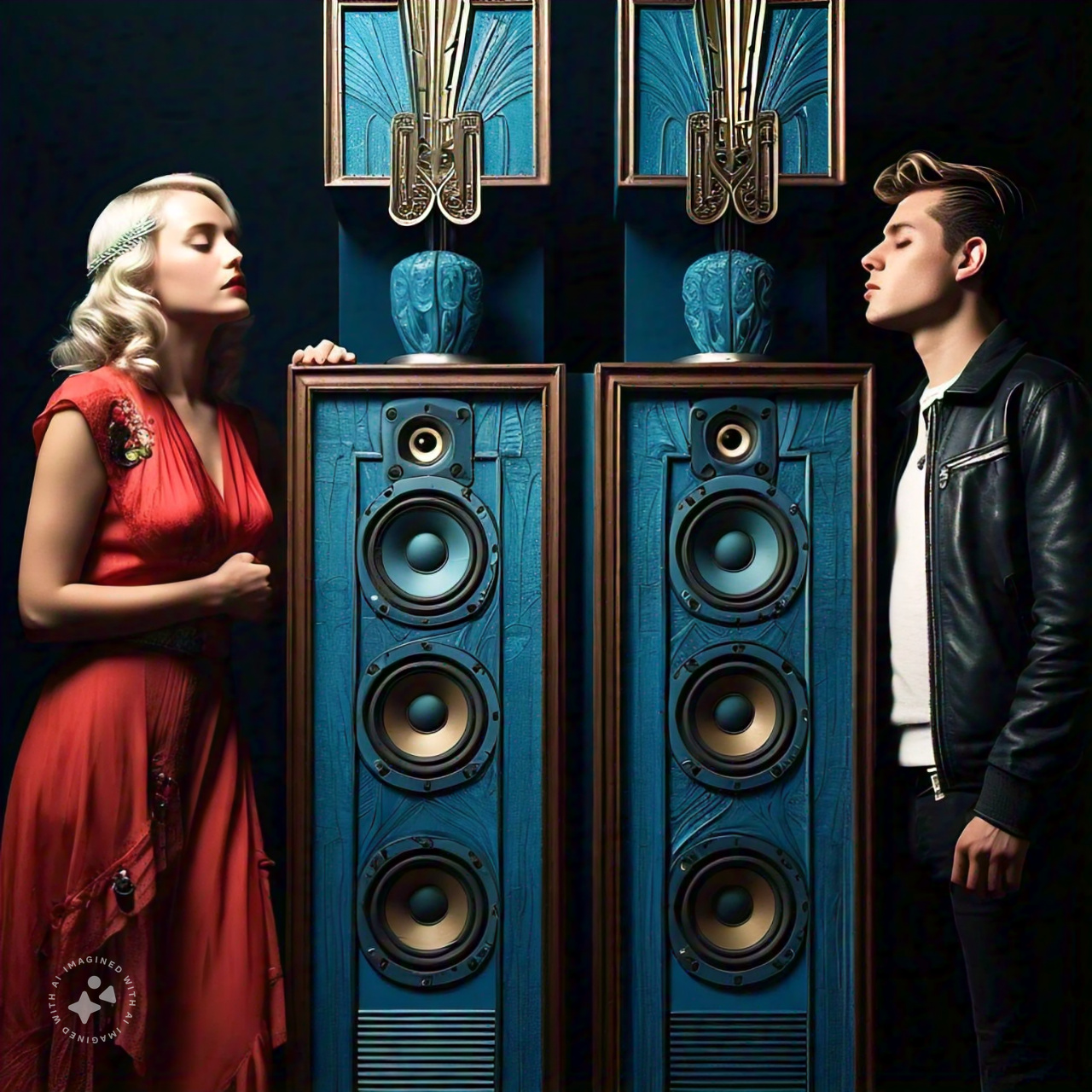They are beautiful in sound as well as appearance.
The Signature models have several upgrades.
Bowers & Wilkins 805 D4 Signature Stand-mount Speakers Highlights
- Massive build
- New tweeter design
- Relatively flat presentation
- Very stylish
John Bowers founded B&W Loudspeakers, Ltd. in 1966 in England, and their first product was the P1, released in 1967. Now, almost 60 years later, I would say their technology has certainly matured. I reviewed the 705 Signature several years ago, and I was excited to see how their stand-mount speakers have improved.
DESIGN:
Two-way Stand-mount, Ported
DRIVERS:
One 1″ Diamond Dome Tweeter
One 6.5″ Continuum Cone Mid/Woofer
FREQUENCY RESPONSE:
42 Hz – 28 kHz, ± 3 dB
CROSSOVER FREQUENCY:
4 kHz, 1st Order (6 dB/octave)
SENSITIVITY:
88 dB SPL, 2.83 Volts @ 1 Meter
HARMONIC DISTORTION:
< 1%, 90 Hz – 20 kHz
< 0.3%, 120 Hz – 20 kHz
NOMINAL IMPEDANCE:
8 Ohms, Minimum 4.6 Ohms
DIMENSIONS:
Height: 17.3″ (440 mm)
Width: 9.4″ (240 mm)
Depth: 14.7″ (373 mm)
Weight:
34.3 Pounds (15.55 kg)
MSRP:
$6,750.00 each.
Website:
Company:
SECRETS Tags:
Bowers & Wilkins, 805 D4, 800 series, stand mounted speakers
Secrets Sponsor
Bowers & Wilkins is one of just a few speaker manufacturers that have drivers in separate enclosures. In this case, the tweeter is mounted on top of the main enclosure in a sort of elongated pod.
The tweeter for the Signature Series is improved over older versions. It consists of a 1″ (25 mm) diamond dome. Diamond consists of carbon, which has an atomic weight of 12. Magnesium’s atomic weight is 24, aluminum is 27, and titanium is 46. The mass of atoms is relative to their atomic weight. The ability of force to accelerate an object, and its inertia to keep going once moving, depends on the mass. The bottom line is that the lower the mass of a speaker driver, the better. The problem is strength and flexibility. You don’t want a speaker cone that flexes during its movement back and forth (the cone, not the surround) because the waveform that is produced by a flexing cone mathematically deconstructs to the original signal and harmonic distortion.
Beryllium has an atomic number of 4. That is really low. Because of this, beryllium is used in some tweeters, but it is a difficult metal to work with, and beryllium dust is very toxic.
Beryllium tweeters have low distortion and fast, accurate sound reproduction, particularly in the high frequencies. This metal is seven times stiffer than aluminum or titanium for the same mass, and sound travels faster through it. Beryllium tweeters are also known for their open, spatial sound. However, most beryllium dome tweeters have a declining frequency response above 15 kHz and an elevated response in the upper treble range.
Diamond tweeters are stronger and stiffer than other materials and have less distortion. They are also stable up to 70 kHz, compared to around 30 kHz for aluminum tweeters. Diamond tweeters are said to sound smoother and warmer than other tweeter materials, and their breakup mode (ringing) is far outside the normal hearing range.
Bowers & Wilkins’ diamond tweeter has a dome made of diamond 40 microns (µ) thick. To put that in perspective, a human hair ranges in thickness from 50 microns to 100 microns, so the B&W tweeter diamond dome is thinner than a human hair. One micron is a thousandth of a millimeter. Diamond is very, very strong and resists flexing.
Diamond consists of carbon atoms bonded to one another, with each carbon atom bonded to four other carbon atoms in a lattice as shown below.
© https://www.chemguide.co.uk/14to16/structure/drawdiamond.html
Graphite (pencil “lead” is graphite and clay), which also consists of carbon atoms, is much different, with each carbon atom bonded to three other carbon atoms through sp2 hybridization. In diamond, the bonds are sp3, and the atoms form tetrahedra with each carbon atom bound to four nearest neighbors. In graphite, they are sp2 orbital hybrids, and the atoms form in planes with each bound to three nearest neighbors 120 degrees apart. Carbon nanotubes also consist of sp2 hybridized orbitals. At least one headphone manufacturer uses carbon nanotubes for the diaphragm.
© https://www.theengineeringchoice.com/what-is-the-structure-of-graphite/
The diamond dome is produced through a process called Chemical Vapor Deposition, or CVD. The dome’s diamond crystal growth conditions are created by thermal dissociation of hydrogen, and a gaseous source of carbon in plasma, with a gas temperature above 2,000 °C. This process is handled for B&W by Element Six, based in Ascot, UK. So the dome is synthetic diamond. Just because it is strong does not mean you can tap on it or touch it. Don’t do that because its very thin structure makes it, well, a bit delicate. The dome only weighs 0.088 grams (88 milligrams).
The dome is covered with a mathematically designed grille, which has a six-star-shaped set of holes (it looks a bit like The Star of David). This allows the high frequencies to pass through without being diffracted. Diffraction occurs when frequencies strike a sharp edge (including the edges of the speaker enclosure), and the size of the holes makes a difference. The edges of the holes in the grille appear to be rounded as can be seen in the tweeter closeup photo below. This will reduce diffraction, but it is expensive to manufacture.
On the topic of audio waveform diffraction, From Akirumusic’s website:
“When the wavelength of the sound wave is longer compared to the size of the obstacle, the diffraction becomes more pronounced. This means that if the wavelength is long and the size of the obstacle is small, the wave spreads out more widely around the obstacle. As a result, waves that would have originally propagated in a straight line can spread out in a semi-circular pattern around the obstacle.”
Diagram above ©Akirumusic (https://akirumusic.com/sound/).
Click on the closeup photo below and use your mouse wheel or left mouse click to enlarge it so you can see the details of the mesh cover.
The midrange/woofer driver is a conventional design, 6.5″ in diameter, with a Continuum Cone™. It is not one of their other designs called an FST driver. FST, or Fixed Suspension Transducer, only works when applied to a midrange-only drive unit. While it helps deliver more accuracy in midrange frequencies, the technology lacks the excursion needed for a midrange/woofer driver. A grille for the mid/woofer comes with the speaker, but I suspect most consumers would not use it.
Here are some notes from Bowers & Wilkins on what they have done to improve the design, including the new tweeter:
- The tweeter grille mesh, moving from a removable mesh to a fixed mesh (2015) and to a fixed mesh with a revised, more open structure for Signature (2023).
- The Tweeter-on-Top housing, moving from an open zinc-aluminum-alloy tube housing with an internal tube-loading system to the Solid Body Tweeter (2015) and today, to a significantly longer Solid Body Tweeter with upgraded two-point decoupling.
- The magnets behind the dome – today, we have fewer magnets but they are higher quality.
- The voice coil – moving to a vented system.
- The HF crossover – with improved primary capacitors and improved bypass caps, plus an improved location (external to the main speaker enclosure and housed in its own volume on the rear of the speaker, affixed to the rear spine)
- The terminals – moving to an improved terminal with higher-quality, lower-lead brass contacts
Don’t forget – in addition to ALL the above – that very early 805s with Diamond Domes still used our famous polyamatic aramid fibre cones (the yellow drive unit material that we were associated with for so long). In a simple two-way speaker, there’s an element of contribution in the XO between the top section of the output of the bass/mid drive unit and the lower portion of the HF dome.
Continuum, the drive unit material we use today, is much cleaner than the old material. Its impact is audible, not only on the expected elements of midrange and bass, but also on how it transitions to HF.
The Continuum cone’s design is based on the concept of optimized and controlled flexibility. This helps it avoid the abrupt transition from pistonic to break-up mode behavior that drastically impair the openness and neutrality of a conventional drive unit. it is a woven composite material created by Bowers & Wilkins and produced in the company’s UK factory. Its design gives highly controlled break-up. Continuum is a triumph for experimental work, with more than 70 iterations and eight years of development prior to launch.
The enclosure is costly to manufacture too. The inner cross-bracing has to be precise. The outside is rounded which requires a forming press. Rounding the edges of the enclosure reduces diffraction of the sound as it exits the drivers.
The forming press takes either 12 layers of beech (805 speakers) or 18 layers (801 speakers) and bends them using up to 80 tons of vertical pressure and 60 tons of horizontal pressure. Each layer of wood is separated from the next by a sheet of heat-activated glue. The forming press is heated – directly, not via steam – to 140 degrees Celsius to activate the glue. Cabinets sit in the forming press for between 17 and 24 mins, depending on the size of the speaker.
The outside consists of either an engineered brown burl veneer or metallic blue paint.
The metallic blue is shown in the photos above. The burl finish is shown in the photo below.
Here is the blue finish again, also showing the optional stands ($1,600/pair).
The process for Midnight Blue Metallic finish is as follows:
• Raw cabinets are robot-sanded using 180 grit, followed by 400 grit: the cabinets are then finished and masked by hand.
• 350 microns of black polyester paint is then applied (x5 coats), using an automated robot and paint mixing system.
• After a minimum of four days curing the cabinets are robot sanded again using 400 grit and then finished and masked by hand.
• Two coats of Midnight Blue Metallic base coat are then applied. Once the first coat has been applied, 2,000 grit paper is used.
• 130 microns of clear topcoat is then applied (4 coats), using a robot and paint mixing system.
• After a minimum of four days curing cabinets are robot sanded and finished by hand, first with 1,200 grit and then 3,000 grit.
• Cabinets are then robot polished for 80 minutes using an extra fine compound. Once completed, the cabinet undergoes an additional 30-minute hand polishing and inspection process.
The process for California Burl is as follows:
• Raw cabinets are robot sanded using 240 grit, followed by 400 grit. Cabinets are then finished and masked by hand.
• Clear polyester is then applied (two initial coats (wet on wet) plus five thick coats), using a robot and paint mixing system.
• After a minimum of four days curing the cabinets are robot sanded using P400 grit and hand finished
• The hand spotting and UV light treating process is then performed to address any sinkage that may be present.
• Cabinets then undergo further robot and hand sanding, starting with 1,200 grit then 2,000 grit followed by 3,000 grit. Cabinet are then polished, once by a robot and then again by hand. Two different polishing compounds grades are used during this process step.
The rear panel, shown below, has two pairs of binding posts for bi-amping or bi-wiring. In conventional use, you connect them together with the supplied jumper cables. You can also see the metal plate that covers the rear of the enclosure.
Here is a photo showing the jumper cables.
The metallic blue finish is really gorgeous. If I owned them, I would put a spotlight in the ceiling above each speaker to highlight the color.
The difference between the Signature series and the others consists of stronger metal bracing, larger capacitors and inductors in the crossover network to handle higher power, and aluminum tubing inside the port. The grille on the tweeter is also different. The improved metal bracing refers to the aluminum top-plate and in the case of the 801 Signature, the use of an aluminum port. The 805 Signature features an upgraded pole on the magnet of the bass/midrange drive unit, plus a larger vent hole for improved current distortion.
I listened to the 805 D4’s using laptops feeding an AURALIC ALTAIR G1 Streamer or OPPO BDP-105 Disc Player through USB-A to USB-B, then to a Pass Labs Xs Preamplifier and Parasound JC 1 + Monoblock Power Amplifiers, or Pass Labs XP-32 Preamplifier to Balanced Audio VK-500 Stereo Power Amplifier. I also have a number of albums stored on a USB thumb drive, plugged into the OPPO BDP-105. Cables were Clarus.
Below are my standard reference albums. I use several of them for every review. I also use newly released albums from Qobuz.
This is turning out to be my favorite album among my standard reference albums, Art Pepper Meets The Rhythm Section. I now wish I had learned to play a saxophone instead of a trombone.
Pepper’s alto sax was tight, clear, and raspy as it should be. Cymbals from the drummer were very up front as I like them. Not too much “ping.” Just the right amount.
Anne Meyers’ Mirror in Mirror album is a blowout on the 805’s. Her violin just sings like a nightingale. High notes were spectacular. That tweeter is very special. But the deep notes of the piano were not lost either. Wow! I heard surprising level of bass on the low notes. Subwoofer not necessary unless you use these in your home theater. Subwoofers are always necessary there.
I am not a Country & Western fan, but some of the albums do give me a kick. This one was released in September, 2024. Very nice steel guitar and deep bass. No excess twang at all. I am surprised at the language that is used in music these days though.
Now this album is more to my liking, released September, 2024. Smooth jazz played on smooth speakers. Great voice, easy to listen to, no overly sibilant “s’s”. Dinnertime. The bass is deep and without boominess. Not easy to do with relatively small drivers. I am glad to see that nearly every new album these days is 24/96, with a few at 24/192. The 24 bits gives much more dynamic range.
Sonny Clark (1931 – 1963) was a classic jazz pianist and composer. This album was recorded in 1958. It was released in mono, but re-released later in stereo. This version is stereo. It sounded great for music that was recorded 66 years ago. All the musicians on this album were famous in their own right. The ride cymbal with the drummer had a great ping and wash. Zildjian K Ride I think, maybe 20″. Classic jazz on fine speakers is a good way to spend an afternoon. I have this album on vinyl too.
Clark died very young, and it is thought he died of a heroin overdose even though the official cause of death was listed as a heart attack. So many jazz musicians of that time had drug addiction problems. Tragic to lose such talent so early.
If an album was mixed with a boost in the treble, the diamond tweeter will expose it. I found this on a Mozart Symphony album. So, how music is mixed will definitely affect the sound. It is probably because the diamond dome is extremely light weight, so it responds to the smallest nuance, and boosted frequencies during the mixing process will produce a lot more nuances.
Here is a summary of my findings:
1 – Plays loud without much audible distortion – Yes
2 – Violins sound clean and natural – Detailed edge transients
3 – Sweet high-end rather than edgy, irritating sound – Yes, but forward high frequencies; however, 2nd-ordered harmonics are predominant
4 – Human voices natural – Yes
5 – Detailed – Yes, very
6 – Congestion at high volume – No
7 – Midrange prevalence – No, slightly recessed
8 – Sibilance – Medium/high
9 – Powerful, punchy bass – Yes
10 – Bass boominess – No
Secrets Sponsor
At 50 Hz, Figure 1 below, and 90 dB SPL, THD was 0.23%, and the 2nd-ordered harmonic was predominant. This is unusual for a small woofer, and what you are going to see is that the 2nd-ordered harmonic was always the predominant one regardless of the frequency. Very unusual, but it is a terrific result, and this is what you are paying for with these speakers.
100 Hz, 93 dB SPL, distortion was 0.68%.
At 1 kHz, Figure 3, the output was lower at 85 dB SPL. For my tests, I always set the volume at 1 kHz and let the other frequencies fall where they may. Distortion was 0.48%. Note that this is THD not THD+N because the microphone picks up room noise. Look at how much larger the 2nd-orderd harmonic is than the 3rd-ordered harmonic and all the others too.
In Figure 4, we can see the spectrum for 5 kHz. The SPL went up to 91 dB. Distortion was 0.033% which is very low for such high volume. That diamond dome only weighs 0.008 grams, which is a lot less than most tweeter cones and domes. Aluminum is more than twice as heavy as carbon, and the dome has to be thicker too. Again, the 2nd-ordered harmonic is the largest. As you will see, this is always the case regardless of the frequency.
And, at 10 kHz, Figure 5, distortion was only 0.37% at 94 dB SPL. This is off-the-chart performance. Expensive, and this is why.
IMD using 60 Hz and 7 kHz (Figure 6) yielded 2.3%. The 60 Hz sine wave comes out of the woofer, and the 7 kHz comes out of the tweeter. The result is the interaction of the two as they travel to the microphone.
Here is the same test as in Figure 6, but with an expanded X axis. There are only four side-peaks on either side of the 7 kHz peak, but they are high.
Another IMD test is 19 kHz and 20 kHz sine waves, Figure 8. In this case, both frequencies are coming out of the tweeter. IMD was only 0.28% even at 92 dB SPL. The diamond dome tweeter is superb.
Figure 9 shows the same results as in Figure 8, but with an expanded X axis. There are three side-peaks, and they are quite low.
Figure 10 is the 1/10th octave test. It is a stress test to show where distortion is concentrated. It is between 500 Hz and 2 kHz, and between, and between 9 kHz and 20 kHz.
The Impulse-Derived Frequency Response and associated Distortion is shown in Figure 11 below. It is taken with five averages. You can see that the midrange is a bit recessed. The tweeter has a higher output. You can also see that the 2nd-ordered harmonic is the largest one throughout the audible band. The response is all the way out to 30 kHz.
The Step Response test, also derived from the Impulse Response, shows that the tweeter and woofer are in positive phase.
A Cumulative Spectral Decay (CSD) is shown in Figure 13, below. There are cabinet and driver resonances, but nothing out of the ordinary.
The Impedance/Phase plot is shown below in Figure 14. Impedance is 42 Ohms at 80 Hz and 4 Ohms at 20 kHz. Phase is + 550 at 24 Hz and – 580 at 90 Hz.
The Frequency Response indicates that the midrange is somewhat recessed compared to the deep bass and the treble. The high frequencies do not sound bright to me, however. This is because of the striking 2nd-ordered harmonic predominance throughout the audible band. This is a very rare finding in a speaker. It delivers a warm, musical sound. I believe that Bowers & Wilkins created the increased treble on purpose because consumers spend a lot of time listening to music off-axis. How often do we sit with the speakers toed in and our chair is exactly where the on-axis lines from the two speakers intersect? For me, I don’t do that very often. I mostly turn on the system and listen to music while I work, or sit on the couch and read, or have dinner in the dining room. I put a dozen albums in the que and listen all day, while I am in several rooms nearby. So, like most speakers, the high frequencies roll off as the listener moves off-axis. I paid attention to this effect with the 805 D4’s, and they sound amazing off-axis.
To test this out, I subsequently ran two Frequency Response tests, using an Impulse Response, with the microphone on-axis and then, 450 off-axis. The results are shown below. You can see that the treble flattens out quite a bit off-axis, but it is still close to flat with respect to the lower frequencies. There is more distortion in the upper midrange.
Notwithstanding all of this, I would like to see an L-pad at the rear to adjust the output of the tweeter for those who prefer less treble even on-axis.
For now, you can still adjust the tweeter output using a linear phase EQ filter add-on (plugin) that can be added to laptop or computer music players that access streaming services such as Tidal and Qobuz. I use MAAT thEQorange Linear EQ for such things. MAAT has several linear phase EQ filters at varying prices. A linear phase EQ filter does not alter the phase. I use the plugin with Audirvana Music Player. The example below is just for illustration of how I would do it if I felt I wanted it. I preferred the balanced sound off-axis where I spend most of my time. I did listen on-axis for certain segments of reference albums. If you want to use EQ such as the MAAT plugins, it is better to attenuate the higher output regions rather than boost the lower ones, as raising output will increase distortion in the boosted region. You can lower the midrange region in the 805 D4 frequency response by using a foam plug in the port opening, including partial blockage by using a plug that has a smaller opening in the center of the plug. Foam port plugs are available on the Internet. Using the port plug and a linear phase EQ filter to attenuate the low frequencies and high frequencies respectively would be the way I would flatten the 805 D4 response, but keep in mind that this would increase the attenuation of the high frequencies off-axis, making the only ideal spot to listen to be directly on-axis.
Bowers & Wilkins has been around for a very long time. They have learned a lot and, I’m sure, have made corrections and improvements over the decades. They have kept the diamond tweeter in the mix. Their 805 D4 Signature Stand-mount Speakers do themselves justice. Even-ordered distortion, even at high volume, makes them sing.
- Built like a tank
- Amazing tweeter
- Stylish color
- Bi-amp or bi-wire
- L-pad for tweeter output adjustment


